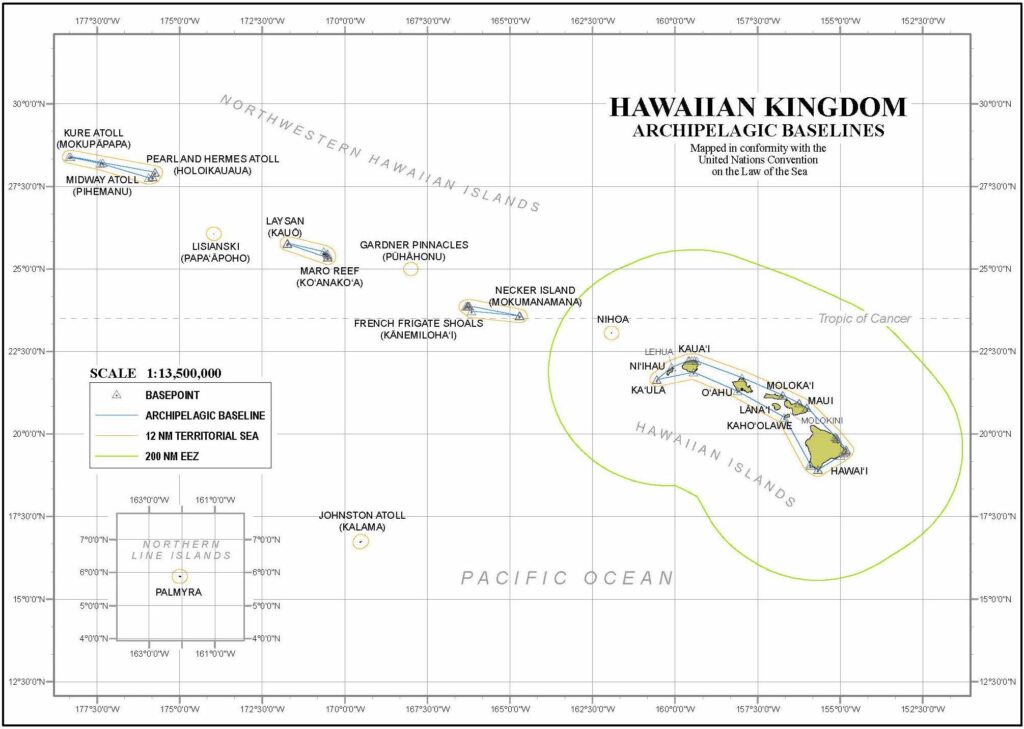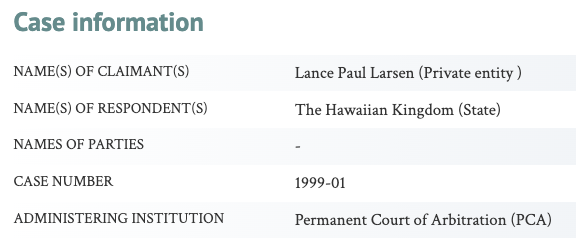Speaking to Pacific island leaders, Reuters reported President Joe Biden said “Russia’s assault on Ukraine in pursuit of imperial ambitions is a flagrant, flagrant violation of the UN Charter, and the basic principles of sovereignty and territorial integrity.” The world should know that this is a classic case of the pot calling the kettle black, which is an idiom that means a person should not criticize another person for a fault they themselves have.
Like Ukraine, the Hawaiian Kingdom was an internationally recognized independent State. Where Ukraine got its independence in 1991 after the collapse of the Soviet Union, the Hawaiian Kingdom achieved its independence when Great Britain and France jointly proclaimed that both countries recognized the Hawaiian Islands as an independent State in 1843. The United States explicitly acknowledged Hawaiian independence on July 6, 1844.
One of the fundamental principles of international law is the sovereignty, which is supreme authority, and territorial integrity of an independent State. Independent States have exclusive authority over its territory that is subject to its own laws and not the laws of any other State.
In 1997, a treaty of friendship, cooperation, and partnership between Ukraine and the Russian Federation was signed that came into force on April 1, 2000. Article 2 of the treaty states that “the High Contracting Parties shall respect each other’s territorial integrity and reaffirm the inviolability of the borders existing between them.”
In 1849, a treaty of friendship, commerce and navigation between the Hawaiian Kingdom and the United States was signed that came into force on November 9, 1850. Territorial integrity is acknowledged in article 8 of the treaty that states “each of the two contracting parties engages that the citizens or subjects of the other residing in their respective states, shall enjoy their property and personal security, or the subjects or citizens of the most favored nation, but subject always to the laws and statutes of the two countries respectively.”
Both Ukraine and the Hawaiian Kingdom established diplomatic relations with their treaty partners. While Ukraine maintained an embassy in Moscow, and Russia maintained an embassy in Kiev, the Hawaiian Kingdom maintained an embassy in Washington, D.C., and the United States maintained an embassy in Honolulu.
Like Russia invaded Ukraine on February 24, 2022, the United States invaded the Hawaiian Kingdom on January 16, 1893. In a presidential investigation, U.S. President Grover Cleveland acknowledged that the U.S. “military demonstration upon the soil of Honolulu was itself an act of war,” which led to the overthrow of the Hawaiian government the following day. The purpose of the invasion and overthrow was to secure Pearl Harbor as a naval base of operations to protect the west coast of the United States from invasion by Japan. The Russian invasion of Ukraine was to buffer an invasion by the North Atlantic Treaty Organization or NATO, which the United States is a member of.
On January 31, 1893, U.S. Captain Alfred Mahan from the Naval War College wrote a letter to the Editor of the New York Times where he advocated seizing the Hawaiian Islands. In his letter, Captain Mahan recognized the Hawaiian Islands, “with their geographical and military importance [to be] unrivaled by that of any other position in the North Pacific.” Mahan used the Hawaiian situation to bolster his argument of building a large naval fleet. He warned that a maritime power could well seize the Hawaiian Islands, and that the United States should take that first step. He wrote, “To hold [the Hawaiian Islands], whether in the supposed case or in war with a European state, implies a great extension of our naval power. Are we ready to undertake this?”
Although President Cleveland apologized for the overthrow of the Hawaiian Kingdom government and entered into a treaty with Queen Lili‘uokalani on December 18, 1893, to restore her to the Hawaiian throne as a constitutional executive monarch, he was prevented from doing so because of the war hawks in the Congress that wanted Pearl Harbor. This consequently placed the Hawaiian Islands in civil unrest under the control of insurgents that received support from Americans in the United States. They were pretending to be a government by calling themselves the provisional government. The reason for the pretending is because President Cleveland’s investigation already concluded “that the provisional government owes its existence to an armed invasion by the United States.” In other words, the insurgents were a puppet of the U.S.
Five years would lapse, and the Cleveland administration was replaced by President William McKinley. U.S. Secretary of the Navy John Young was an advocate for annexing the Hawaiian Islands. Secretary Long was influenced by Assistant Secretary of the Navy Theodore Roosevelt, who would later become President in 1901. On May 3, 1897, Roosevelt wrote a letter to Captain Mahan. He stated, “I need not tell you that as regards Hawaii I take your views absolutely, as indeed I do on foreign policy generally. If I had my way we would annex those islands tomorrow.” Roosevelt also stated that Cleveland’s handling of the Hawaiian situation was “a colossal crime, and we should be guilty of aiding him after the fact if we do not reverse what he did.” Roosevelt also assured Mahan, that “Secretary Long shares our views. He believes we should take the islands, and I have just been preparing some memoranda for him to use at the Cabinet meeting tomorrow.”
The opportunity for the United States to seize the Hawaiian Islands occurred at the height of the Spanish-American War. On July 6, 1898, the war hawks in the Congress passed a joint resolution declaring that the Hawaiian Islands had been annexed and President McKinley signed it into law the following day.
The opportunity for Russia to seize a portion of Ukrainian territory came after sham referendums where the people of the regions of Donetsk, Luhansk, Kherson and Zaporizhzhia voted to be Russian and not remain Ukrainian. On September 30, 2022, Reuters reported that “Russian President Vladimir Putin announced Russia had ‘four new regions’ in a speech in the Kremliin on Friday in which he outlined Russia’s annexation of four Ukrainian regions that Moscow’s forces have partially seized during a seven-month conflict with Ukraine.”
Despite the American annexation of the Hawaiian Islands and the Russian annexation of the four Ukrainian regions, they remain illegal under international law. Because it is illegal it did not alter the territorial integrity of both the Hawaiian Kingdom and Ukraine as independent States. As Professor Malcolm Shaws wrote, “It is, however, clear today that the acquisition of territory by force alone is illegal under international law.” And according to The Handbook of Humanitarian Law in Armed Conflicts (1995):
The international law of belligerent occupation must therefore be understood as meaning that the occupying power is not sovereign, but exercises provisional and temporary control over foreign territory. The legal situation of the territory can be altered only through a peace treaty. International law does not permit annexation of territory of another State.
The return of unlawfully annexed territory occurs when there are changes in the physical power of the usurping State. Since the usurping State has no lawful authority over annexed territory, its possession is based purely on power and not law. Similarly, the abductor of a kidnapped child, being an act prohibited by law, does not become the parent of the child by force despite the length of the kidnapping. And when the child is eventually rescued and the power of the abductor eliminated and taken into custody, the child can then return to the family.
Unlike Ukraine, there was no Reuters news agency in the 1890s informing the world of the illegal activities of the United States against the Hawaiian Kingdom and the illegal annexation of the Hawaiian Islands for military purposes during the Spanish-American War. While there is a difference in time, the Russian actions bear a striking resemblance to the United States actions in seizing the entire territory of the Hawaiian Kingdom. While both the American and Russian actions are unlawful, the Hawaiian Kingdom, like Ukraine, remain independent States under international law together with their territorial integrity intact despite the unlawful annexations.
In the case of the Hawaiian Kingdom, the Permanent Court of Arbitration, in Larsen v. Hawaiian Kingdom, acknowledged the continued existence of the Hawaiian Kingdom as a “State” under international law in 1999, which includes its territorial integrity. In the case of Ukraine, everyone in the world already knows that Ukraine is a “State” under international law.
This is a classic case of the American pot calling the Russian kettle black.
For more information on the belligerent occupation of the Hawaiian Kingdom by the United States and the unilateral annexation of Hawaiian territory, read Dr. Keanu Sai’s law article Backstory – Larsen v. Hawaiian Kingdom at the Permanent Court of Arbitration (1999-2001).




